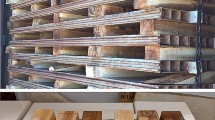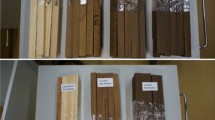Abstract
This study was aimed at evaluating the properties of juvenile and mature wood from Hevea brasiliensis untapped and with tapping panels. Boards were taken from a 53-year-old Hevea brasiliensis plantation located in Tabapuã, São Paulo, Brazil. Half of the boards had the tapping panels region, and the other half had the untapped region. The results showed that: (1) there were increases of 6.6 % in the volumetric shrinkage of mature wood when compared with juvenile wood; (2) the densities and chemical properties of juvenile and mature woods are statistically equal; and (3) the tapping panel does not influence the properties of rubberwood.
Similar content being viewed by others
Avoid common mistakes on your manuscript.
1 Introduction
The heterogeneity of wood generally causes a lot of inconvenience to its manufacturing and processing industries. The material’s chemical and physical discontinuity occurs due to several factors: species, silviculture and especially wood anatomy. Juvenile wood can be defined as being close to the pith and, technologically, it differs from mature wood on account of several properties (Ferreira et al. 2011; Naji et al. 2011).
The air-dried density of wood near the pith of Hevea brasiliensis RRIM2020 clone is between 0.50 and 0.58 g/cm3, whereas near the bark it is between 0.54 and 0.61 g/cm3 (Naji et al. 2011). According to Matan and Kyokong (2003), basic density and the density at 12 % moisture content in the juvenile wood of H. brasiliensis were 0.55 and 0.614 g/cm3, respectively, and the maximum volumetric shrinkage was 8.2 % whereas mature wood was not studied by the authors. Ratnasingam and Ioras (2012) studied the wood of 25- to 30-year-old H. brasiliensis and concluded that the maximum tangential, radial, and axial shrinkages were 7.3, 4.5, and 0.5 %, respectively.
Okino et al. (2010) studied the chemical properties of wood from six clones of 17- to 41-year-old H. brasiliensis trees, and concluded that the insoluble and soluble lignin, cellulose, hemicelluloses, and extractives contents were 21.19 to 25.59 %, of 1.60 to 2.54 %, of 47.66 to 54.56 %, of 21.71 to 25.15 %, and of 2.68 to 3.45 %, respectively.
Nevertheless, the wood quality of H. brasiliensis is affected by forestry practices, and more studies are needed to determine the influence of these practices on the quality of wood-based material (Naji et al. 2011).
Tapping panel process removes a thin layer of bark and thereby enables smooth latex flow and the regeneration of the bark. However, according to Ratnasingam and Scholz (2008), unsuitable tapping panels have negative consequences on the regeneration of wood and the tapping marks reduce the yield during the processing of rubberwood.
Since there is little information on the effects of rubber tapping on the properties of wood, the aim of this study was to evaluate the effects of tapping panels on properties of juvenile and mature woods from Hevea brasiliensis.
2 Materials and methods
This study utilized wood from six 53-year-old ungrafted Hevea brasiliensis trees from a reforestation (9.93 ha) located in Tabapuã (20° 57′ 50″ South Latitude and 49° 01′ 55″ West longitude), São Paulo, Brazil.
Rubber tapping was performed uninterrupted for 45 years. The trees were felled and sectioned into 1.0-m logs. Half of each first log contained the region with the tapping panels and the other part the region without the tapping panels. The logs with an average diameter of 37 cm were cut into flat sawn boards. The boards that contained the pith were cut into 60-mm thick pieces for this study.
Subsequently, specimens were removed from untapped and tapped panels woods according to the standards presented in ABNT NBR-7190 (1997) for physical characterization of juvenile and mature woods. The chemical properties were characterized by standards presented in TAPPI (1999). The juvenile and mature wood regions were defined according to the study by Ferreira et al. (2011).
3 Results and discussion
The density at 0 and 12 % moisture content of juvenile and mature woods from untapped Hevea brasiliensis are presented in Table 1. The results are similar to those cited by Naji et al. (2011) and Matan and Kyokong (2003).
It can be seen in Table 1 that the densities of mature wood from H. brasiliensis are not significantly different to those of juvenile wood. The non-influence of the kind of wood on density can also be explained by the high levels of extractives content in the juvenile wood of the trees studied.
The shrinkage in juvenile and mature woods from untapped H. brasiliensis is presented in Table 1. It was found that the volumetric, tangential and radial shrinkages of mature wood were greater than those of juvenile wood. However, the axial shrinkage of this kind of wood was greater than that of mature wood. These results are consistent with those obtained by Matan and Kyokong (2003) as well as those reported by Ratnasingam and Ioras (2012).
The lignin, holocellulose, and extractive contents of juvenile and mature woods from untapped H. brasiliensis are presented in Table 2. These results are similar to those cited by Okino et al. (2010).
In addition, the effect of tapping panels on the physicochemical properties of H. brasiliensis wood is shown in detail in Tables 1 and 2.
The current study demonstrates that the tapping panels did not cause changes in these properties of wood. However, these results are expected because according to Ratnasingam and Scholz (2008) only unsuitable tapping panels have negative consequences on the characteristics of wood. Thus, the suitable rubber tapping does not change the properties of rubberwood.
4 Conclusion
In verifying the properties of H. brasiliensis with and without tapping panels, it was concluded that: (1) there were increases of 6.6 % in the volumetric shrinkage of mature wood when compared with juvenile wood; and (2) the densities and chemical properties of juvenile and mature woods are statistically equal. It was demonstrated that the tapping panel does not influence the properties of rubberwood, and this material can be utilized by wood furniture industry after the rubber tapping period.
References
ABNT NBR 7190 (1997) Design of wooden structures. Associação Brasileira de Normas Técnicas, ABNT, Rio de Janeiro (In Portuguese)
Ferreira AL, Severo ETD, Calonego FW (2011) Determination of fiber length and juvenile and mature wood zones from Hevea brasiliensis trees grown in Brazil. Eur J Wood Prod 69:659–662
Matan N, Kyokong B (2003) Effect of moisture content on some physical and mechanical properties of juvenile rubberwood (Hevea brasiliensis Muell. Arg.). Songklanakarin J Sci Technol 25(3):327–340
Naji HR, Sahri MH, Nobuchi T, Bakar ES (2011) The effect of growth rate on wood density and anatomical characteristics of rubberwood (Hevea brasiliensis Muell. Arg.) in two different clonal trails. J Nat Prod Plant Resour 1(2):71–80
Okino EYA, Resck IS, Santana MAE, Cruz CLSC, Santos PHO, Falcomer VAS (2010) Evaluation of wood chemical constituents of Hevea brasiliensis and Cupressus decomposed by Gloeophyllum striatum using CP/MAS 13C NMR and HPLC techniques. J Trop For Sci 22(2):184–196
Ratnasingam J, Ioras F (2012) Effect of heat treatment on the machining and other properties of rubberwood. Eur J Wood Prod 70:759–761
Ratnasingam J, Scholz F (2008) Yield studying of rubberwood lumber during rough milling operations. Holz Roh Werkst 66(6):467–468
Technical Association of the Pulp and Paper Industry—TAPPI (1999) Preparation of Wood for Chemical Analysis, TAPPI 12 wd-82. Acid-Insoluble Lignin in Wood and Pulp, TAPPI 222 om-98. TAPPI, Atlanta
Acknowledgments
The authors thank the Coordinator for the Improvement of Higher Level Personnel (CAPES), Brazil, for financial support.
Author information
Authors and Affiliations
Corresponding author
Rights and permissions
About this article
Cite this article
Severo, E.T.D., Oliveira, E.F., Sansígolo, C.A. et al. Properties of juvenile and mature woods of Hevea brasiliensis untapped and with tapping panels. Eur. J. Wood Prod. 71, 815–818 (2013). https://doi.org/10.1007/s00107-013-0731-2
Received:
Published:
Issue Date:
DOI: https://doi.org/10.1007/s00107-013-0731-2




